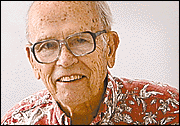Advertisement - Click to support our sponsors.


Hawaii’s World
I wrote three columns starting late January documenting that Hawaii is one of the best places in the world to be poor. With Hawaii Coast
Guard, boaters are
in good handsThis Thanksgiving I'll add we are one of the best places in the world to be lost at sea. Just ask the families of Tom Zelko and Ian Buscher, who drifted for more than three days in October in their disabled 15-foot skiff -- sun-parched, out of gas, without radio contact, lost, running low on food and liquids.
The Coast Guard finally found them as it has some 250 other boats in distress in this area in the past year, though none other for such a long time.
Search and rescue is one of the main responsibilities of the 14th Coast Guard District, headquartered in Honolulu. Others include law enforcement and marine environmental protection.
Lt. Michael C. Wessel is senior search and rescue controller for the district. He previously trained in Miami. Searches are quite successful there, too, helped by heavy East Coast sea traffic. Our sea traffic is lonesome by comparison so searches here can be more challenging.
Plus factors for those lost at sea in Hawaiian waters include mostly good weather, warm water and occasional rain squalls to provide drinking water -- all aids to survival.
The biggest help to survival is one Zelko and Buscher didn't have and weren't required to have because of the small size of their boat -- a distress radio. They had a cell phone, but it became useless when they got too far away from land.
On a murky day, which theirs turned out to be, a compass might have helped, too. Again not required in their case -- and never before needed by these two pals as they navigated visually between Oahu and Molokai for a day's surfing and beer-drinking.
Wesson says the phases in a rescue are, first, uncertainty; second, on alert; and, third, distress when the search and rescue forces swing into full action. In the uncertainty phase there is much phoning to see if those "lost" can be located ashore, maybe at a friendly bar.
In the alert phase there are heightened concern, more calls and checks of every port where the boat might be.
A distress finding sends the Coast Guard into full search-and-rescue action. In the Hawaii area this means broadcasting alerts every 30 minutes to all ships and boats at sea plus deployment as needed of four C-130 search aircraft, its four short-range H-65 helicopters, four patrol boats and its two buoy tenders.
WESSEL says our area is relatively resource-poor but still has performed reasonably well to save our lost seafarers.
Boats with a radio can eliminate the first two phases by simply broadcasting "Mayday ...Mayday...Mayday" on the distress frequency channel. Satellites circling overhead may locate their position within an hour or two.
Even better, a 121.5-megahertz radio beacon costing $200 can help with emergency position discovery. The best protection of all is an $800, 406-megahertz radio beacon that will transmit the boat's registration, names of the owners and shore contacts, along with location data on Channel 16, the distress frequency. Wessel knows $800 seems expensive but notes it is great insurance for only $80 a year spread over 10 years.
He sees it as a "best buy" particularly since many owners invest more than $20,000 in their boats. The 121.5-megahertz service will phase out in 2005.
It would be a happy Thanksgiving for the Coast Guard if all boats at sea had 406-megahertz beacons. That, says Wessel, would take the "search" out of "search and rescue."
A.A. Smyser is the contributing editor
and former editor of the the Star-Bulletin
His column runs Tuesday and Thursday.